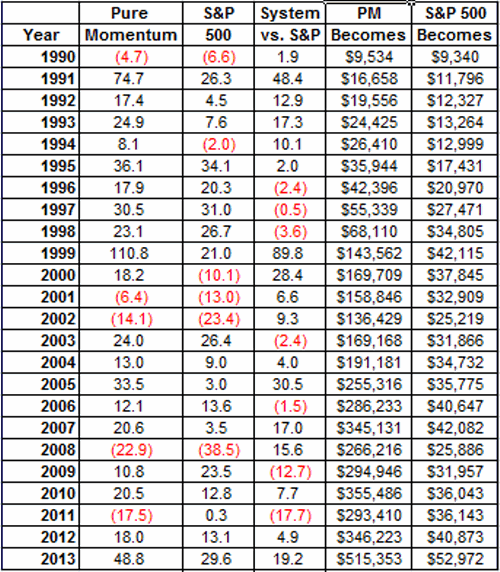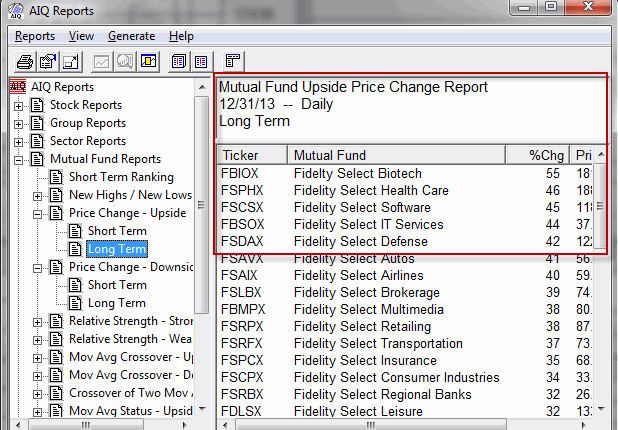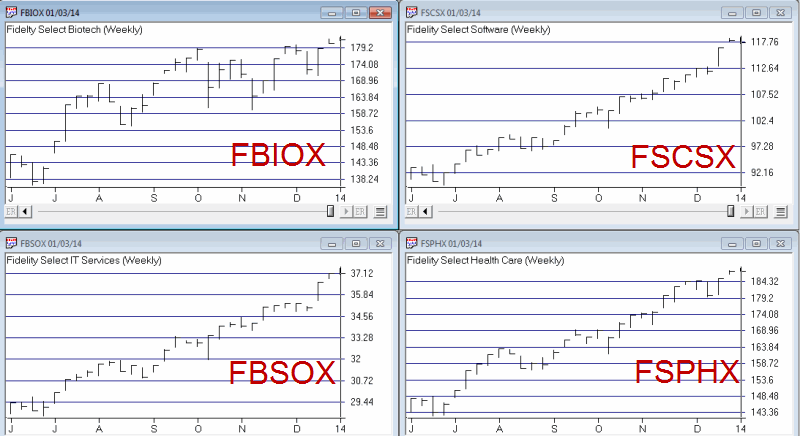Please see my new article in Technical Analysis of Stocks & Commodities magazine titled “New Tricks With Old Indicators” (http://traders.com/) On Sale Now.
Please find below a complimentary link from MTA (Market Technicians Association) my webinar titled “Finding Exceptional Opportunities with ETF, Options and Seasonal Trends.
If there is one is universally true statement that I can make about trading systems in general and in specific, it is this – they sure are fun when they work.
When I first started trading – back in what I longingly refer to as the “Hair Era” in my life – I figured that I would be a “gut” trader – i.e., I was determined to rely on my keen instincts and intuitive reasoning to decide when to buy and sell based on current market conditions.
That was not fun. After continually getting sucked into the swirling vortex of emotion – not to mention the abject fear associated with seeing your money disappear – I found that I was getting the, um, back of my front so to speak, burned so many times that I was having difficulty, um, sitting down, so to speak.
Eventually I evolved into a systematic trader. Now I am able to sit down much more often. A few strategies that I have developed over the years have stood the test of time and become something of “bread and butter” strategies. And they sure are fun when they work. To wit….
Jay’s Pure Momentum System
In 2001, I published an article in “Technical Analysis of Stocks and Commodities” magazine titled “Trade Sector Funds with Pure Momentum”, which detailed one specific and simple trading method. While in fact this is only one of many sector trading systems that I have developed over the years – and not necessarily the best one – it remains one of my favorites. Probably because it is just so gosh darn simple. When I was young my Momma told me to be a simple kind of man (or was it a Freebird she told me to be?). Well, in any event, here are the “simple kind of rules” using Fidelity Select Sector funds:
-After the close of the last trading day of the month identify the five Fidelity Select Sector funds that have the largest gain over the previous 240 trading days.
-For this system, ignore Select Gold (ticker FSAGX). If FSAGX appears in the top 5 funds then skip it and include the 6th highest rated funds.
-If fewer than five funds showed a gain over the previous 240 trading days, then hold cash in that portion of the portfolio (i.e., if only 3 funds showed a gain, then 60% of the portfolio would be in those funds and 40% of the portfolio would be in cash).
-If you sell more than one fund at the end of a month, then rebalance the proceeds in the new funds being purchased (example, you are selling Funds A and B and buying Funds C and D. You have $12,000 in Fund A and $10,000 in Fund B. Split the difference and put $11,000 each into funds C and D).
And that’s all there is to it.
The Results
Figure 1 displays the annual results of this method. 
Figure 1 – Jay’s Pure Momentum Annual Results
Figure 2 displays the current portfolio.
Figure 2 – Jay’s Pure Momentum Current Portfolio
My opinion as to why this system has performed well over the years is, well – what else – simple. The effects of a positive change in the fundamentals for a given industry or sector typically take a long time to play out. Thus, by finding the sectors that are performing well you very often find the sectors that are most likely to continue to perform well for a while.
 Figure 3 – 12/31/13 Test (Courtesy: AIQ TradingExpert)
Figure 3 – 12/31/13 Test (Courtesy: AIQ TradingExpert) 
Figure 4 – Several Current Sector Fund Holdings (Courtesy: AIQ TradingExpert)
Summary
Obviously 2013 was a banner year for this system. There is nothing like a rip roaring bull market to help things along. A couple of caveats:
*First off, sometimes people new to momentum investing will look at the charts in Figure 4 and say “Whoa, these things have already rallied sharply, I’m not jumping into those.” That’s something you’ll have to get over to use this system.
*Secondly, while the long-term yearly numbers look pretty good, there was about a 45% drawdown along the way in 2008. So it is not for the faint of heart.
*One other danger is that some people see +48.8% for the year in 2013 and get it in their head that this will occur again often. History suggests otherwise.
Still, an average annual return of +20.7% since 1990 (versus +8.9% for the S&P 500) isn’t bad – especially for a “Simple Kind of System.”
Best of Good Fortune in 2014.
Jay Kaeppel



Besides AIQ is there another web site where one could fine the 5 strongest Fidelity/Rydex sectors for the past 240 days. Also, thanks for sharing all the information. I have followed you for many years. Dave
Dave…I use Fidelity’s web site. At the end of each month, they update all their funds for 12 month performance. Maybe not as precise as tracking 240 TDs exactly, but close enough. Here’s the link:
http://fundresearch.fidelity.com/mutual-funds/category-performance-annual-total-returns/SECTOR
Keith
Your comment “this is only one of many sector trading systems that I have developed over the years – and not necessarily the best one – it remains one of my favorites.” That begs the question, “What is your best one?” Maybe you’ll write about that next week.
So happy to brought up PM again. I started trading this live back in 2008 when you wrote about it. That year was a bit of a shocker when trying something new, but that year was a shocker for just about every system on the planet. I’m very pleased with the 2013 results, and love the fact this is a very simple system to maintain. Most months I changed out 0 or 1 ETF, and rarely 2 or more. I can manage this system with about 15 minutes of effort each month. ….. Keith
Dear Jay,
I wonder if the system works well on slightly different set of Fidelity Funds such as http://www.fidelity.ca/cs/Satellite/en/public/products/mutual_funds/sector
Hi Jay: I just finished reading your book: Seasonal Stick Market Trends – and man, I want to let you know how much I appreciate the research and the logic! Of course I have questions – like why is the January Barometer not part of your KTI? Does it make sense to add +1 or +2 to all the subsequent parameters if the January Barometer was a +1 or +2 (or +3)? Certainly that would have a dramatic impact when January is strong on the rest of the year’s KTI. What are your thoughts? I can’t imagine that you haven’t considered it. Also, your post here regarding sector rotation certainly gets the juices flowing when considering the substitution of the best sectors for the Dow or SPX Index funds when incorporating KTI points. I’ll post a review on Amazon. Thanks, Rick
Rick,
Yes the January Barometer is a very useful tool. The reason it is not included in the KTI is because by design the KTI is comprised of “things” that are knowable in advance. In other words, one could calculate future KTI values ad infinitum into the future using only a calender. Thanks for the comments.
Jay
Jay … can one use this strategy on sector ETFs such as the SPDR & Vanguard sector ETFs?
Yes. The only caveats are, a) I haven’t specifically tested with SDPRs and/or Vanguard funds so can’t comment on how results would compare. Similar but different would be my guess. Also, not sure of Vanguard switching restrictions. Want to avoid being charged fees getting “locked out” due to switching too frequently. No switching restrictions with ETFs but do have to factor in commissions.
Not sure if that answer helps or not, but there you have it!
Jay
why 240 days vs 1 year which is 251. I assume there is a very good reason for this. kind of want to know before I try this using Fidelity’s annual results as one other person had suggested.
thanks
Chuck, nothing magical about 240 days. In fact that was simply the default in the software I used initially in testing. I have heard from many people that claim that they just use 1-year rate-of-change – some claim to have gotten better results although I can’t quantify that. Bottom line: if you have access to 1-year ROC data and no easy way to calculate 240 trading day ROC the 1-yer data will work just fine. Jay
Jay can you give any update on this method for 2014, and YTD through 08/31/2015?
Done…http://tinyurl.com/oh3tgks